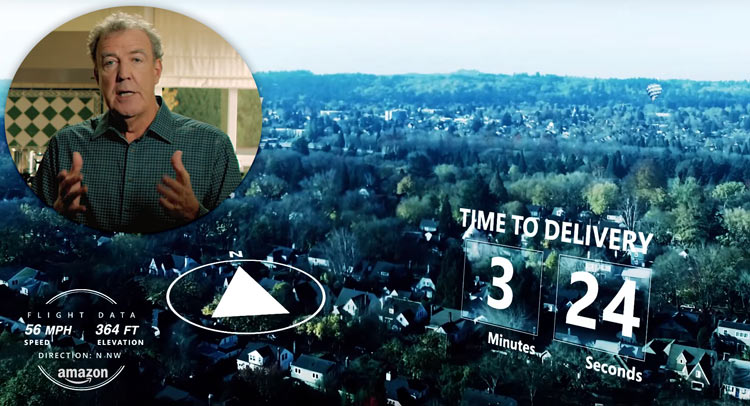Amazon has employed ex-Top Gear host Jeremy Clarkson for yet another ad, this time to give us a look at the latest evolution of its upcoming Prime Air drone delivery service.
Clarkson, who is currently readying a new show for Amazon together with former Top Gear colleagues, Richard Hammond and James May, gives us a tour of the internet giant’s vision for the Prime Air program that uses unmanned aerial devices, also known as drones, to deliver packages to customers in less than 30 minutes.
The e-commerce company’s newest drone prototype looks bigger and less fragile than the first iteration teased nearly two years ago, while another visible difference is that, instead of carrying a package below, this one accepts it into its fuselage. Amazon says that its latest drone weighs less than 55 pounds (25 kg) and can carry packages weighing up to 5 pounds (2.3 kg).
Once it picks up an order at one of Amazon’s warehouses, it takes off vertically before flying horizontally at around 400 feet (122 meters) at distances of up to around 15 miles (24km) reaching speeds of approximately 55mph (88 km/h). Amazon says the drones are built with multiple redundancies, as well “sophisticated ‘sense and avoid’ technology, plus a high degree of automation, to safely operate beyond the line of sight”.
In the video, Clarkson says, “In time, there will be a whole family of Amazon drones, different designs for different environments.” The online retailer itself said that it has more than a dozen prototypes currently being developed in their research and development labs, adding that the look and characteristics of the drones will evolve over time.
Right now, Amazon’s biggest hurdle before it can be cleared for takeoff is the US Federal Aviation Administration’s (FAA) strict regulations for drones, which are technically called unmanned aircraft systems (UAS). FAA approved tests in the USA earlier this year, but is currently working on new set of regulations for the use of drones for commercial purposes.
Amazon said that it’s working with policymakers to bring the service to customers as soon as possible, but it doesn’t have a specific timeframe: “We will deploy when and where we have the regulatory support needed to safely realize our vision,” the company said in a statement.








